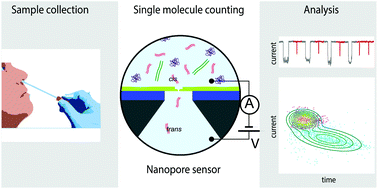Purely electrical SARS-CoV-2 sensing based on single-molecule counting†
Abstract
The majority of RNA based COVID-19 diagnostics employ enzymatic amplification to achieve high sensitivity, but this relies on arbitrary thresholding, which complicates the comparison of test results and may lead to false outcomes. Here we introduce solid-state nanopore sensing for label-free quantification of SARS-CoV-2 RNA in clinical nasal swab samples. This PCR-free method involves reverse transcribing a target gene on the viral RNA before enzymatically digesting all but the resulting dsDNA. Ratiometric quantification of RNA abundance is achieved by single-molecule counting and length-based nanopore identification of dsDNA from a SARS-CoV-2 gene and a human reference gene. We graded nasal swab samples from >15 subjects and find that the SARS-CoV-2 ratiometric nanopore index correlates well with the reported RT-qPCR threshold cycle for positive classified samples. Remarkably, nanopore analysis also reports quantitative positive outcomes for clinical samples classified as negative by RT-qPCR, suggesting that the method may be used to diagnose COVID-19 in samples that may evade detection. We show that the sample preparation workflow can be implemented using a compact microfluidic device with integrated thermal control for semi-automated processing of extremely small sample volumes, offering a viable route towards automated, fast and affordable RNA quantification in a small and portable device.



 Please wait while we load your content...
Please wait while we load your content...